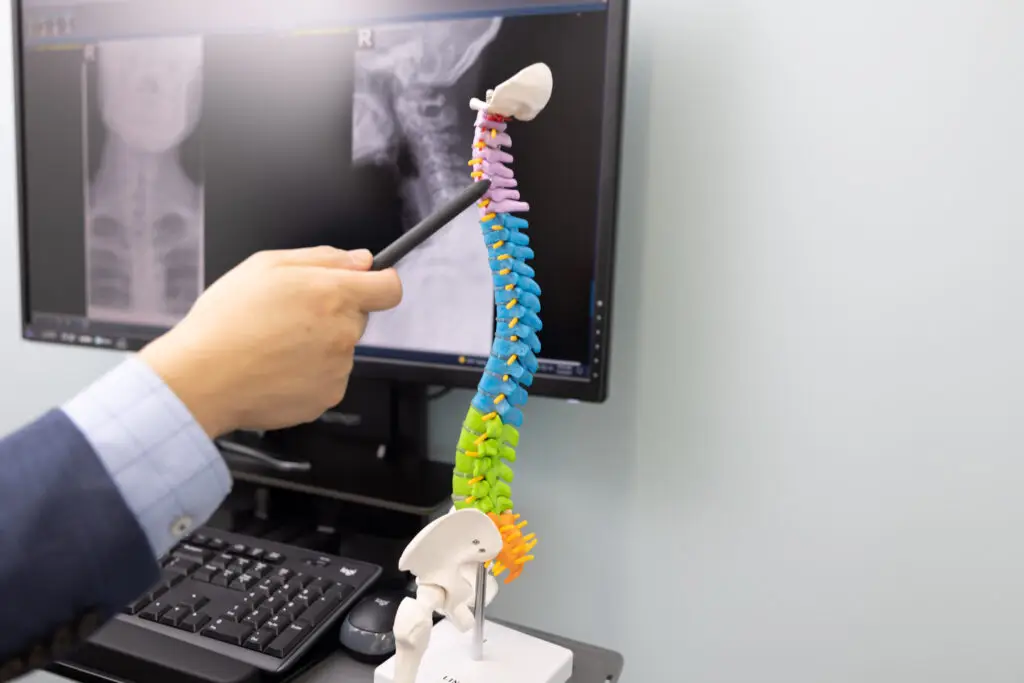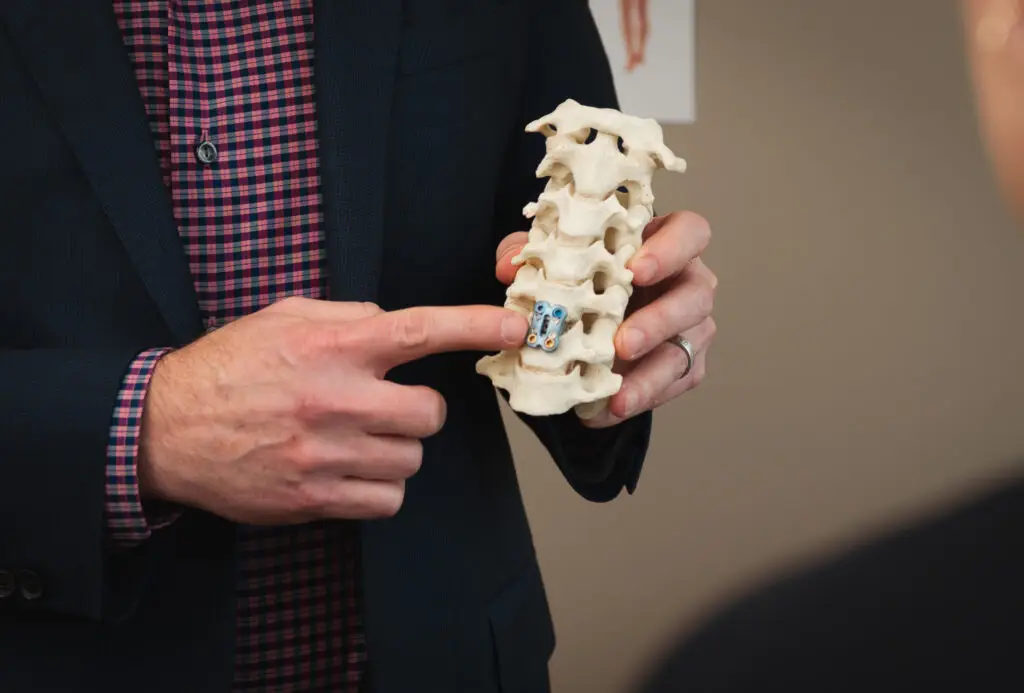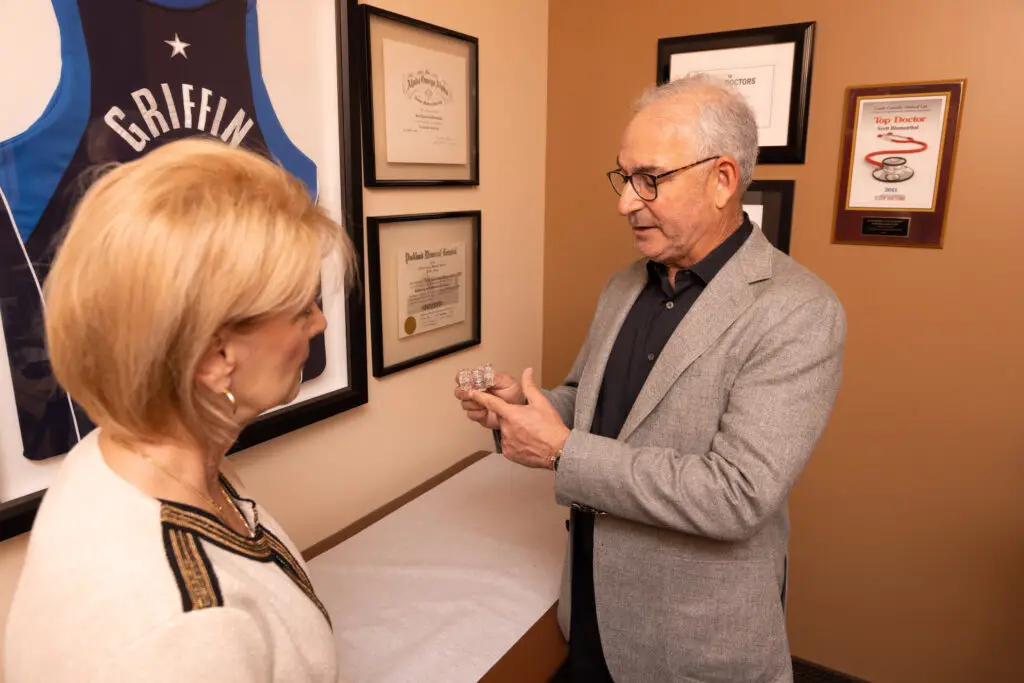Under Pressure: Nerve Conduction and Electromyography Studies
how we can help
Nerve Conduction and Electromyography Overview
A nerve conduction study (NCS) is a diagnostic test to evaluate how well the peripheral nervous system is functioning and to determine the possibility of peripheral nerve damage. The study focuses on peripheral nerves located outside the central nervous system. An NCS is often performed alongside an electromyogram to determine if radicular symptoms are the result of a muscle disorder or a nerve issue. An electromyogram (EMG) measures the electrical activity of the muscles both at rest and during contraction.
Nerve conduction studies are often performed for conditions that cause symptoms such as numbness, tingling, or weakness in the arms or legs which are caused by pressure on nerve roots as the nerve becomes “pinched” or compressed. It works by testing the transmission of these signals, especially the speed at which they travel and their “strength”. Electrical stimulation is used to measure the response of the nerves.
With healthy nerves, electrical signals can travel up to 120 miles per hour. If a nerve is damaged, the transmission will be slower and weaker. By stimulating the nerves at different places, a Nerve Conduction Study can determine the specific site of the compromised nerve. Testing can also evaluate for non-spinal causes of limb pain and weakness such as carpal tunnel syndrome and peripheral neuropathy.
Nerve conduction testing is completed by measuring the length of time required for an electrical signal to pass down the nerve root. Muscles cannot contract well if they don’t have full nerve flow, and this limits a person’s ability to function normally. Back and neck NCS/EMG studies help identify why a muscle may be weak and where a nerve blockage (pinched nerve) may be occurring.
Table of Contents
Treats
Diagnosing
Nerve Conduction Study (NCS):
Recovery
Conservative Treatment Options:
Patients Ask:
What is a pinched nerve?
Texas Back Institute Responds:
The term radiculopathy refers to a range of symptoms produced by the pinching of a nerve root in the spinal column. The spinal cord plays a critical role in transmitting signals from the brain to the muscles. A pinched nerve can occur at any of the levels of the spine (cervical, thoracic, or lumbar). A common cause of radiculopathy comes from the narrowing of the space where nerve roots exit the spine, which can be the result of spinal stenosis, bone spurs, herniated discs, or other conditions.
What is the Difference Between a Nerve Conduction Studies and an Electromyogram?
Used to diagnose nerve damage, an NCS examines how efficiently motor and sensory nerves are working by measuring the speed of electrical impulses through the nerves. These impulses are transmitted by nerve cells which control muscle movement. During the test, the target nerve is stimulated with the use of electrode patches applied to the top of the skin. A mild electrical impulse is delivered, which stimulates the nerve.
The resulting nerve activity is recorded by the other electrodes, as is the speed of the nerve signals. There is no pain associated with a nerve conduction study, though some patients report feeling a sensation like a static electricity shock that lasts a few seconds.
An NCS is also called a nerve conduction velocity (NCV).
(insert photo or illustration suggesting an EMG report)
Electromyography documents the electrical activity of muscles when at rest or when contracted to determine muscle health. During electromyography, a pin with a tiny electrode is inserted into the muscle being tested. The patient is asked to make a series of movements that will cause the muscle to contract. The pin is connected to a special recording device and the device will deliver a series of audible clicks detailing the results corresponding to each muscle movement. The test is painless, except for a slight pinprick when the pin is inserted into the muscle and a minor cramping sensation during muscle contraction.

Patients Ask:
Why do I need to have both an NCS and an EMG?
Texas Back Institute Responds: The results of an EMG and NCS can help a physician make an accurate diagnosis as to the possible cause of radicular symptoms and the specific location of compressed nerves. Muscle soreness can occur after these tests but typically subsides within a week. Because nerve impulses control muscle movement in the body, a movement issue can be caused by conditions affecting the nerves or the muscles – or potentially both.

Pinched Nerve Symptoms
(insert illustration suggesting a pinched nerve)
Patients who have a compressed (pinched) or irritated nerve have a standard set of symptoms, depending on where the pinched nerve is located.
Cervical Radiculopathy (Neck) Symptoms:
- Stiffness or pain in the neck
- Numbness or tingling in the arm or hand
- Weakness in the shoulder, arm, or hand
- Loss of sensation in the arm or hand
- Cervicogenic headaches that mimic migraines
Thoracic Radiculopathy (Mid-Back) Symptoms:
- Pain felt in the middle of the back
- Radiating pain to the front of chest and shoulders
- Numbness and tingling from the back to upper chest
- Muscle weakness
- Unusual stiffness in the legs
- Inability to bend backwards or turn the trunk
- In severe cases, temporary paralysis beneath the point of nerve compression
Lumbar Radiculopathy (Low Back) Symptoms:
- Pain in the low back
- Radiating pain that spreads to the buttocks, hip, groin, or leg
- Numbness and tingling that occurs in the back or legs
- Muscle weakness
- Muscle spasms
- Foot drop refers to the inability to lift the front part of the foot and toes may drag on the ground while walking
Patients Ask:
Can the symptoms from a pinched nerve come and go?
Texas Back Institute Responds:Yes, these symptoms can come and go. The severity and duration of radicular symptoms varies based on factors such as the underlying cause, nerve compression level, and individual differences. Some people may experience intermittent pain, while others may have more persistent symptoms. Early evaluation – which may include NCS and EMG testing – ensures accurate diagnosis and effective management. If you’re experiencing back or neck pain, a spine specialist like the physicians at Texas Back can assess your condition and recommend appropriate treatment.
Treatment Options
If a nerve conduction study indicates a compressed nerve, physicians will typically offer conservative care interventions first. Treatment may consist of:
- Rest and Immobilization
Allowing the affected area to rest and avoid exacerbating activities
- Physical Therapy
Targeting exercises to strengthen the muscles and alleviate nerve tension
- Hot and Cold Therapy
Alternating heat and cold can help with symptoms
Injections deliver corticosteroids directly into the epidural space around the spine, reducing inflammation and providing relief from radiating back pain caused by the compressed nerve while allowing the nerve time to heal

(insert photo of TBI physician consulting with a patient)
Patients Ask:
What if conservative care options don’t work to alleviate the pain?
Texas Back Institute Responds:
Texas Back Institute always recommends surgery as a last resort. If surgery is necessary, endoscopic surgery is an effective technique for taking pressure off the nerves in the spine. Endoscopic spine surgery is a technique used to address a variety of spinal conditions, including disc herniations and bone spurs. This approach results in much smaller incisions, less muscle damage and scar tissue, and minimal blood loss. Other benefits include shorter hospital stays and recovery times. The beauty of minimally invasive surgery is that it allows the surgeon to take pressure off nerves without doing damage to other tissues around the site of the problem.
When Should I See a Doctor?
If a nerve is pinched because of swelling, the resulting symptoms usually go away once the inflammation subsides. However, if nerves are compressed because of a herniated disc or other structural problems, permanent nerve damage may occur. If symptoms persist, worsen, or are triggered by specific movements, a medical evaluation is advised. Early diagnosis and appropriate care are essential to prevent further damage or complications.
If you are experiencing shooting pain in your legs or arms, this could be caused by pressure on the nerves in your spine. This pain can often be relieved with a surgical procedure to decompress the nerves. The skilled surgeons at the Texas Back Institute have helped thousands of patients regain a pain-free, better quality of life. Click here to set up an appointment with an expert.

Learn more
Frequently Asked Questions
The term radiculopathy refers to a range of symptoms produced by the pinching of a nerve root in the spinal column. The spinal cord plays a critical role in transmitting signals from the brain to the muscles. A pinched nerve can occur at any of the levels of the spine (cervical, thoracic, or lumbar). A common cause of radiculopathy comes from the narrowing of the space where nerve roots exit the spine, which can be the result of spinal stenosis, bone spurs, herniated discs, or other conditions.
The results of an EMG and NCS can help a physician make an accurate diagnosis as to the possible cause of radicular symptoms and the specific location of compressed nerves. Muscle soreness can occur after these tests but typically subsides within a week. Because nerve impulses control muscle movement in the body, a movement issue can be caused by conditions affecting the nerves or the muscles – or potentially both.
Yes, these symptoms can come and go. The severity and duration of radicular symptoms varies based on factors such as the underlying cause, nerve compression level, and individual differences. Some people may experience intermittent pain, while others may have more persistent symptoms. Early evaluation – which may include NCS and EMG testing – ensures accurate diagnosis and effective management. If you’re experiencing back or neck pain, a spine specialist like the physicians at Texas Back can assess your condition and recommend appropriate treatment.
Texas Back Institute always recommends surgery as a last resort. If surgery is necessary, endoscopic surgery is an effective technique for taking pressure off the nerves in the spine. Endoscopic spine surgery is a technique used to address a variety of spinal conditions, including disc herniations and bone spurs. This approach results in much smaller incisions, less muscle damage and scar tissue, and minimal blood loss. Other benefits include shorter hospital stays and recovery times. The beauty of minimally invasive surgery is that it allows the surgeon to take pressure off nerves without doing damage to other tissues around the site of the problem.
Locations


